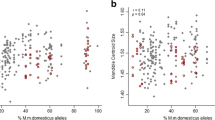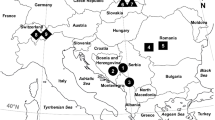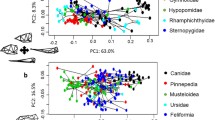Abstract
Patterns of genetic covariance between characters (represented by the covariance matrix \({\varvec{G}}\)) play an important role in morphological evolution, since they interact with the evolutionary forces acting over populations. They are also expected to influence the patterns expressed in their phenotypic counterparts \(({\varvec{P}})\), because of limits imposed by multiple developmental and functional restrictions on the genotype/phenotype map. We have investigated genetic covariances in the skull and mandible of the vesper mouse (Calomys expulsus) in order to estimate the degree of similarity between genetic and phenotypic covariances and its potential roots on developmental and functional factors shaping those integration patterns. We use a classic ad hoc analysis of morphological integration based on current state of art of developmental/functional factors during mammalian ontogeny and also applied a novel methodology that makes use of simulated evolutionary responses. We have obtained \({\varvec{P}}\) and \({\varvec{G}}\) that are strongly similar, for both skull and mandible; their similarity is achieved through the spatial and temporal organization of developmental and functional interactions, which are consistently recognized as hypothesis of trait associations in both matrices.





Similar content being viewed by others
References
Adams, D. C., Cardini, A., Monteiro, L. R., O’Higgins, P., & Rohlf, F. J. (2011). Morphometrics and phylogenetics: Principal components of shape from cranial modules are neither appropriate nor effective cladistic characters. Journal of Human Evolution, 60(2), 240–243. doi:10.1016/j.jhevol.2010.02.003.
Almeida, F. C., Bonvicino, C. R., & Cordeiro-Estrela, P. (2007). Phylogeny and temporal diversification of calomys (rodentia, sigmodontinae): Implications for the biogeography of an endemic genus of the open/dry biomes of South America. Molecular Phylogenetics and Evolution, 42(2), 449–466. doi:10.1016/j.ympev.2006.07.005.
Atchley, W. R., & Hall, B. K. (1991). A model for development and evolution of complex morphological structures. Biological Reviews, 66, 101–157.
Berner, D. (2012). How much can the orientation of g’s eigenvectors tell us about genetic constraints? Ecology and Evolution, 2(8), 1834–1842. doi:10.1002/ece3.306.
Berner, D., Kaeuffer, R., Grandchamp, A. C., Raeymaekers, J. A. M., Räsänen, K., & Hendry, A. P. (2011). Quantitative genetic inheritance of morphological divergence in a lake-stream stickleback ecotype pair: Implications for reproductive isolation. Journal of Evolutionary Biology, 1–9. doi:10.1111/j.1420-9101.2011.02330.x.
Bonvicino, C., Lima, J., & Almeida, F. (2003). A new species of calomys waterhouse (rodentia, Sigmodontinae) from the cerrado of central brazil. Revista Brasileira de Zoologia, 20(2), 301–307.
Bonvicino, C. R., & Almeida, F. C. (2000). Karyotype, morphology and taxonomic status of calomys expulsus (rodentia: Sigmodontinae). Mammalia, 64, 339–351.
Bookstein, F. L. (1991). Morphometric tools for landmark data: Geometry and biology. Cambridge: Cambridge University Press.
Bookstein, F. L., Chernoff, B., Elder, R., & Strauss, R. (1985). Morphometrics in evolutionary biology. Philadelphia: The Academy of Natural Sciences of Philadelphia.
Cheverud, J. M. (1984). Quantitative genetics and developmental constraints on evolution by selection. Journal of Theoretical Biology, 110, 155–172.
Cheverud, J. M. (1988). A comparison of genetic and phenotypic correlations. Evolution, 42(5), 958–968.
Cheverud, J. M. (1995). Morphological integration in the saddle-back tamarin (Saguinus fuscicollis) cranium. American Naturalist, 145(1), 63–89.
Cheverud, J. M. (1996). Developmental integration and the evolution of pleiotropy. American Zoology, 36, 44–50.
Cheverud, J. M. (2006). Modular pleiotropic effects of quantitative trait loci on morphological traits. In G. Schlosser & G. P. Wagner (Eds.), Modularity in development and evolution (1st ed., pp. 132–153). Chicago: The University of Chicago Press.
Cheverud, J. M., & Marroig, G. (2007). Comparing covariance matrices: Random skewers method compared to the common principal components model. Genetics and Molecular Biology, 30, 461–469. doi:10.1590/S1415-47572007000300027.
Cheverud, J. M., Routman, E. J., & Irschick, D. J. (1997). Pleiotropic effects of individual gene loci on mandibular morphology. Evolution, 51(6), 2006–2016.
Cheverud, J. M., Wagner, G. P., & Dow, M. M. (1989). Methods for the comparative analysis of variation patterns. Evolution, 38(3), 201–213.
Dochtermann, N. A. (2011). Testing cheverud’s conjecture for behavioral correlations and behavioral syndromes. Evolution, 65(6), 1814–1820. doi:10.1111/j.1558-5646.2011.01264.x.
Dryden, I. L., & Mardia, K. V. (1998). Statistical shape analysis. New York: Wiley.
Falconer, D. S., & Mackay, T. F. C. (1996). Introduction to quantitative genetics (4th ed.). Harlow, Essex: Addison Wesley Longman.
Franz-Odendaal, T. A. (2011). Epigenetics in bone and cartilage development. In B. Hallgrímsson & B. K. Hall (Eds.), Epigenetics: Linking genotype and phenotype in development and evolution (1st ed., pp. 195–220). Oakland, CA: University of California Press.
Hallgrímsson, B., Jamniczky, H., Young, N. M., Rolian, C., Parsons, T. E., Boughner, J. C., et al. (2009). Deciphering the palimpsest: Studying the relationship between morphological integration and phenotypic covariation. Evolutionary Biology, 36(4), 355–376. doi:10.1007/s11692-009-9076-5.
Hallgrímsson, B., & Lieberman, D. E. (2008). Mouse models and the evolutionary developmental biology of the skull. Integrative and Comparative Biology, 48(3), 373–384. doi:10.1093/icb/icn076.
Hansen, T. F., & Houle, D. (2008). Measuring and comparing evolvability and constraint in multivariate characters. Journal of Evolutionary Biology, 21(5), 1201–1219. doi:10.1111/j.1420-9101.2008.01573.x.
Herring, S. W. (2011). Muscle-bone interactions and the development of skeletal phenotype. In B. Hallgrímsson & B. K. Hall (Eds.), Epigenetics: Linking genotype and phenotype in development and evolution (1st ed., pp. 221–237). Oakland, CA: University of California Press.
Hershkovitz, P. (1962). Evolution of neotropical cricetine rodents (muridae) with special reference to the phyllotine group. Fieldiana: Zoology, 46, 1–524.
Hill, W. G., & Thompson, R. (1978). Probabilities of non-positive definite between-group or genetic covariance matrices. Biometrics, 34(3), 429–439.
Klingenberg, C. P. (2008). Morphological integration and developmental modularity. Annual Review of Ecology, Evolution, and Systematics, 39(1), 115–132. doi:10.1146/annurev.ecolsys.37.091305.110054.
Klingenberg, C. P., & Leamy, L. J. (2001). Quantitative genetics of geometric shape in the mouse mandible. Evolution, 55, 2342–2352.
Klingenberg, C. P., Leamy, L. J., & Cheverud, J. M. (2004). Integration and modularity of quantitative trait locus effects on geometric shape in the mouse mandible. Genetics, 166, 1909–1921.
Krupinski, P., Chickarmane, V., & Peterson, C. (2011). Simulating the mammalian blastocyst-molecular and mechanical interactions pattern the embryo. PLoS Computational Biology, 7(5), e1001,128. doi:10.1371/journal.pcbi.1001128.
Lande, R. (1979). Quantitative genetic analysis of multivariate evolution applied to brain: body size allometry. Evolution, 33(1), 402–416.
Lande, R. (1980). The genetic covariance between characters maintained by pleiotropic mutations. Genetics, 94, 203–215.
Leamy, L. J., Routman, E. J., & Cheverud, J. M. (1999). Quantitative trait loci for early and late developing skull characters in mice: A test of the genetic independence model of morphological integration. The American Naturalist, 153, 201–214. doi:10.1086/303165.
Lessels, C. M., & Boag, P. T. (1987). Unrepeatable repeatabilities: A common mistake. The Auk, 2, 116–121.
Linde, Kvd, & Houle, D. (2009). Inferring the nature of allometry from geometric data. Evolutionary Biology, 36(3), 311–322. doi:10.1007/s11692-009-9061-z.
Lynch, M., & Walsh, B. (1998). Genetics and analysis of quantitative traits. Sunderland: Sinauer Associates.
Mantel, N. (1967). The detection of disease clustering and a generalized regression approach. Cancer Research, 27, 209–220.
Marroig, G., & Cheverud, J. M. (2001). A comparison of phenotypic variation and covariation patterns and the role of phylogeny, ecology, and ontogeny during cranial evolution of new world monkeys. Evolution, 55(12), 2576–2600.
Marroig, G., & Cheverud, J. M. (2005). Size as a line of least evolutionary resistance: Diet and adaptive morphological radiation in new world monkeys. Evolution, 59(5), 1128–1142.
Marroig, G., de Vivo, M., & Cheverud, J. M. (2004). Cranial evolution in sakis (Pithecia, Platyrrhini) II: Evolutionary processes and morphological integration. Journal of Evolutionary Biology, 17(1), 144–155. doi:10.1046/j.1420-9101.2003.00653.x.
Marroig, G., Melo, D. A. R., & Garcia, G. (2012). Modularity, noise and natural selection. Evolution, 66(5), 1506–1524. doi:10.1111/j.1558-5646.2011.01555.x.
Marroig, G., Shirai, L. T., Porto, A., de Oliveira, F., & de Conto, V. (2009). The evolution of modularity in the mammalian skull II: Evolutionary consequences. Evolutionary Biology, 36(1), 136–148. doi:10.1007/s11692-009-9051-1.
Marroig, G., Melo, D., Porto, A., Sebastião, H., & Garcia, G. (2011). Selection response decomposition (SRD): A new tool for dissecting differences and similarities between matrices. Evolutionary Biology, 38(2), 225–241. doi:10.1007/s11692-010-9107-2.
Martínez-Abadías, N., Esparza, M., Sjøvold, T., González-José, R., Hernández, M., & Klingenberg, C.P. (2011). Pervasive genetic integration directs the evolution of human skull shape. Evolution, 66(4), 1010–1023. doi:10.5061/dryad.12g3c7ht.
Márquez, E. J., Cabeen, R., Woods, R. P., & Houle, D. (2012). The measurement of local variation in shape. Evolutionary Biology, 39(3), 419–439. doi:10.1007/s11692-012-9159-6.
Meyer, K. (2007). WOMBAT: A tool for mixed model analyses in quantitative genetics by restricted maximum likelihood (REML). Journal of Zhejiang University Science B, 8(11), 815–821. doi:10.1631/jzus.2007.B0815.
Meyer, K., & Kirkpatrick, M. (2008). Perils of parsimony: Properties of reduced-rank estimates of genetic covariance matrices. Genetics, 180(2), 1153–1166. doi:10.1534/genetics.108.090159.
Mezey, J. G., Cheverud, J. M., & Wagner, G. P. (2000). Is the genotype/phenotype map modular? A statistical approach using mouse quantitative trait loci data. Genetics, 156, 305–311.
Mitteroecker, P. (2009). The developmental basis of variational modularity: Insights from quantitative genetics, morphometrics, and developmental biology. Evolutionary Biology, 36(4), 377–385. doi:10.1007/s11692-009-9075-6.
Mitteroecker, P., & Bookstein, F. L. (2007). The conceptual and statistical relationship between modularity and morphological integration. Systematic Biology, 56(5), 818–836. doi:10.1080/10635150701648029.
Olson, E., & Miller, R. (1958). Morphological integration. Chicago: University of Chicago Press.
Polly, P. D. (2008). Developmental dynamics and g-matrices: Can morphometric spaces be used to model phenotypic evolution? Evolutionary Biology, 35(2), 83–96. doi:10.1007/s11692-008-9020-0.
Porto, A., Oliveira, F. B., Shirai, L. T., de Conto, V., & Marroig, G. (2009). The evolution of modularity in the mammalian skull i: Morphological integration patterns and magnitudes. Evolutionary Biology, 36(1), 118–135.
Porto, A., Shirai, L. T., de Oliveira, F. B., & Marroig, G. (2013). Size variation, growth strategies, and the evolution of modularity in the mammalian skull. Evolution, 67(11), 3305–3322. doi:10.1111/evo.12177.
R Core Team (2013). R: A language and environment for statistical computing. Vienna, Austria: R Foundation for Statistical Computing.
Ramaesh, T., & Bard, J. B. L. (2003). The growth and morphogenesis of the early mouse mandible: A quantitative analysis. Journal of Anatomy, 203, 213–222. doi:10.1046/j.1469-7580.2003.00210.x.
Reusch, T., & Blanckenhorn, W. U. (1998). Quantitative genetics of the dung fly sepsis cynipsea: Cheverud’s conjecture revisited. Heredity, 81, 111–119.
Roff, D. A. (1995). The estimation of genetic correlations from phenotypic correlations: A test of cheverud’s conjecture. Heredity, 74, 481–490.
Roff, D. A. (1997). Evolutionary quantitative genetics. New York: Chapman & Hall.
Roff, D. A., & Fairbairn, D. J. (2011). Path analysis of the genetic integration of traits in the sand cricket: a novel use of BLUPs. Journal of Evolutionary Biology, 1–13. doi:10.1111/j.1420-9101.2011.02315.x.
Rohlf, F. J. (2006). tpsDig2, version 2.6. Department of Ecology and Evolution. Stony Brook, New York: SUNY.
Roseman, C. C., Kenny-Hunt, J. P., & Cheverud, J. M. (2009). Phenotypic integration without modularity: Testing hypotheses about the distribution of pleiotropic quantitative trait loci in a continuous space. Evolutionary Biology, 36(3), 282–291. doi:10.1007/s11692-009-9067-6.
Runcie, D. E., & Mukherjee, S. (2013). Dissecting high-dimensional phenotypes with bayesian sparse factor analysis of genetic covariance matrices. Genetics, 194(3), 753–767. doi:10.1534/genetics.113.151217.
Schluter, D. (1996). Adaptive radiation along genetic lines of least resistance. Evolution, 50(5), 1766–1774.
Shaw, R. G. (1987). Maximum-likelihood approaches applied to quantitative genetics of natural populations. Evolution, 41, 812–826.
Shirai, L. T., & Marroig, G. (2010). Skull modularity in neotropical marsupials and monkeys: Size variation and evolutionary constraint and flexibility. Journal of experimental zoology Part B, Molecular and developmental evolution, 314B(June), 663–683. doi:10.1002/jez.b.21367.
Steppan, S. J., Adkins, R., & Anderson, J. (2004). Phylogeny and divergence-date estimates of rapid radiations in muroid rodents based on multiple nuclear genes. Systematic Biology, 53, 533–553.
Steppan, S. J., Phillips, P. C., & Houle, D. (2002). Comparative quantitative genetics: Evolution of the g matrix. Trends in Ecology and Evolution, 17, 320–327.
Theobald, D. L., & Wuttke, D. S. (2006). Empirical bayes hierarchical models for regularizing maximum likelihood estimation in the matrix gaussian procrustes problem. Proceedings of the National Academy of Sciences, 103(49), 18,521–18,527. doi:10.1073/pnas.0508445103.
Tiedemann, H. B., Schneltzer, E., Zeiser, S., Hoesel, B., Beckers, J., Przemeck, G. K. H., et al. (2012). From dynamic expression patterns to boundary formation in the presomitic mesoderm. PLoS Computational Biology, 8(6), e1002,586. doi:10.1371/journal.pcbi.1002586.
Turing, A. M. (1952). The chemical basis of morphogenesis. Philosophical Transactions of the Royal Society of London, 237(641), 37–72.
Wagner, G. P. (1984). On the eigenvalue distribution of genetic and phenotypic dispersion matrices: Evidence for a nonrandom organization of quantitative character variation. Journal of Mathematical Biology, 21, 77–95.
Wagner, G. P. (1996). Homologues, natural kinds and the evolution of modularity. The American Zoologist, 36, 36–43.
Wagner, G. P., & Altenberg, L. (1996). Perspective: Complex adaptations and the evolution of evolvability. Evolution, 50, 967–976.
Watson, R. A., Wagner, G. P., Pavlicev, M., Weinreich, D. M., & Mills, R. (2013). The evolution of phenotypic correlations and ‘developmental memory’. Evolution, 67(4), 1124–1138. doi:10.1111/evo.12337.
Willmore, K. E., Roseman, C. C., Rogers, J., Cheverud, J. M., & Richtsmeier, J. T. (2009). Comparison of mandibular phenotypic and genetic integration between baboon and mouse. Evolutionary Biology, 36(1), 19–36. doi:10.1007/s11692-009-9056-9.
Wolf, J. B., Frankino, W. A., Agrawal, A. F., Iii, E. D. B., & Moore, A. J. (2001). Developmental interactions and the constituents of quantitative variation. Evolution, 55(2), 232–245. doi:10.1111/j.0014-3820.2001.tb01289.x.
Zelditch, M. L., & Carmichael, A. C. (1989). Ontogenetic variation in patterns of developmental and functional integration in skulls of sigmodon fulviventer. Evolution, 43, 814–824.
Zelditch, M. L., Swiderski, D. L., Sheets, H. D., & Fink, W. L. (2004). Geometric morphometrics for biologists: A primer (1st ed.). San Diego: Elsevier.
Acknowledgments
We would like to thank N. P. Barros, A. M. Marcondes, F. Almeida, L. Araripe, J. M. Freschi for help with lab work; F. A. Machado, D. Melo, and two anonymous reviewers for comments on early drafts. We also thank D. Runcie and S. Murkherjee for help with their BSFG model codes. This work has been supported by grants from CNPq (Conselho Nacional de Pesquisa e Desenvolvimento), FAPERJ (Fundação de Amparo à Pesquisa do Estado do Rio de Janeiro), FAPESP (Fundação de Amparo à Pesquisa do Estado de São Paulo), MMA (Ministério do Meio Ambiente) and MCT (Ministério de Ciência e Tecnologia).
Author information
Authors and Affiliations
Corresponding author
Electronic supplementary material
Below is the link to the electronic supplementary material.
Rights and permissions
About this article
Cite this article
Garcia, G., Hingst-Zaher, E., Cerqueira, R. et al. Quantitative Genetics and Modularity in Cranial and Mandibular Morphology of Calomys expulsus . Evol Biol 41, 619–636 (2014). https://doi.org/10.1007/s11692-014-9293-4
Received:
Accepted:
Published:
Issue Date:
DOI: https://doi.org/10.1007/s11692-014-9293-4




